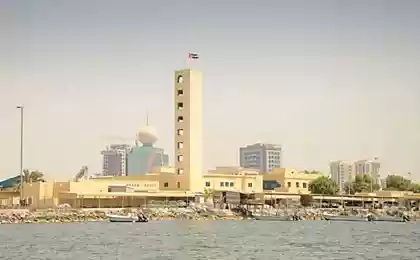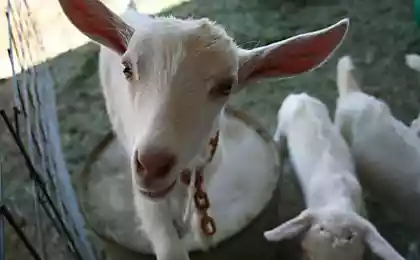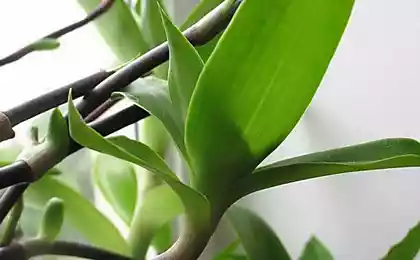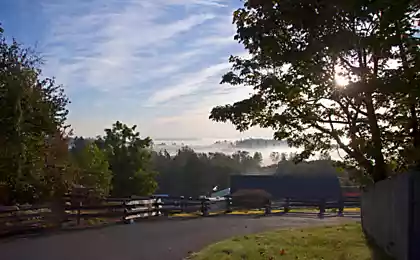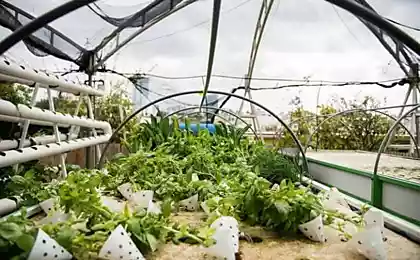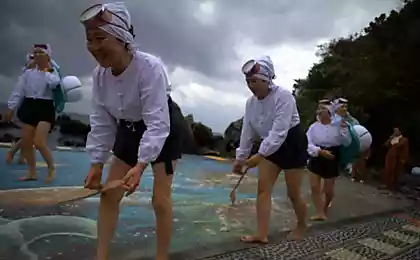2000
Golden Pearl Farm
On the island of Palawan in southwestern Philippines, the only living person in the world who revealed the secret of the production of rare species dragotsennostey- gold pearls. By the fragile natural pearls are treated like royal jewelry. Each oyster is required 5 years to produce one such gem, with the slightest jolt could kill her.

A small motorboat maneuver between rows of ropes stretched over a vast area used for the production of gold pearls. Five divers wear a mask and diving and dive into the turquoise water. Coming season collecting pearls. In this place, surrounded on all sides by the 20 th islands, oyster-producing pearls, protected from strong currents. First oysters spend 2 years in an incubator, and then grow for 3 years at a depth of 15 meters in quiet warm waters of the South China Sea.
This farm of pearls are harvested is 500 km. from Manila and it is very well protected from the emissions of the big city. Absolutely all the forces thrown out to protect the oysters from external influence and negative impact on their growth.
Jacques Branell, since 1979 director and co-founder of the farm, is very worried about their possessions. He began to examine them more closely to the sky, flying his helicopter. No detail is overlooked. On the ground, he wears a pink shirt, hat and jogging runs to inspect the farm. In English, he gives orders to his Filipino assistant, who is trying everywhere to follow the chief.
In fact, Jacques is more concerned with what lies beneath the waves. Fishing with dynamite and cyanide are still prevalent among fishermen Palawan archipelago. Because of this, many corals have died, and now the same thing could threaten oysters. Owners pearl farms even provide local authorities with new motor boats so that they can closely monitor the fishermen and to protect the natural resources that are around.
View from the window of a helicopter of the islands of Palawan, which is a pearl farm.

"Cultivation of pearls is very labor-intensive process," explains Jacques. "Any change in temperature and water conditions may affect the oysters. Everything feels and experiences oyster, affects gem and can spoil its quality. "For 38 years I have been the cultivation of pearls, but still learning, constantly learning something new. Mining gold pearls very difficult task. To achieve perfection in this business you need to overcome a long way ».
Before you put oysters in the sea after 2 years incubator, each placed a small nucleus around which will grow a pearl. Then within 3 years divers ex will periodically get cells with oysters and turn them to pearls were perfectly round, as well as X-rays shine through them to make sure that everything is fine pearl.
But the most difficult part of the process of growing pearls oysters became excretion «Pinctada Maxima». 15 years, biologists have wrestled with breeding rare species of oysters. Now Jacques is the only company in the world that has the secrets of the production of gold pearls.
The divers returned to shore with the first part of the crop. They bring baskets full of oysters in which the pearls and are, but in spite of all the care for a few years, no one can guarantee excellent quality. A few hours later, in the studio, Jacques Brannel evaluates the first gems of the new harvest. "Not all the pearls may have a golden color, some are white or champagne color. From 700 thousand pearls that are produced on farms, Jacques, over 75% are considered to be of the highest quality pearls.
One of the workers bring the pearl, looking at which Jacques eyes light up. "This - the pearl of the highest quality - Hanadama», he exclaims with pride.
Among Jacques Brannelya employs more than 1,000 people in the Philippines are open 12 stores, which produced and sold the entire farm pearls.
Brannel Jacques, a former pilot of civil aviation, came to the Philippines for more than 30 years ago after being sold for the debts of his farm on cultivation of black pearls in Polynesia. But now he said that he had received good value for their previous failures. Jacques argues that does not pursue wealth, as already achieved everything he wanted. His house is located in the prestigious area of Manila, and most recently, he bought a small "Flower Island", where he rebuilt the former resort and made it their second home. Jack loves the Philippines, he married a local woman and dreams to his golden pearls have become a symbol of the archipelago, the same as it was black pearls in Tahiti.
Pearl Farm.

Jacques Brannel flew his helicopter to a pearl farm.

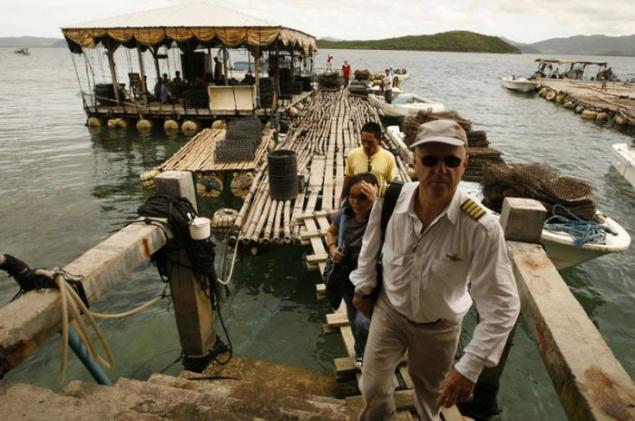

On this board the positions of all the cells are painted with oysters on the farm №3.

Biologist Doris Domingo, head of Fermilab, considering gold pearl under a microscope.

Oysters 3 ex-types: (left to right) a white, gold, black.
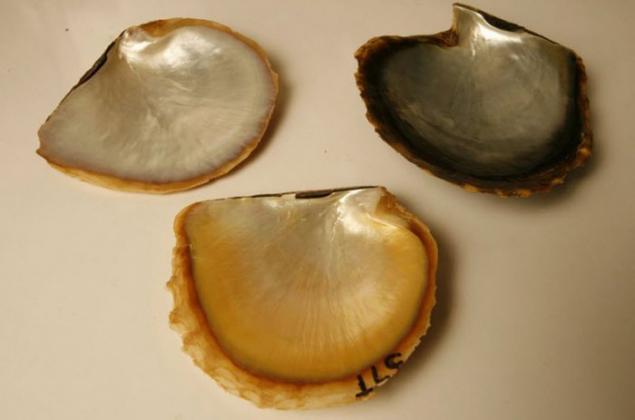
Young oysters are carefully cleaned of dirt and parasites, before placing them in the new cells.
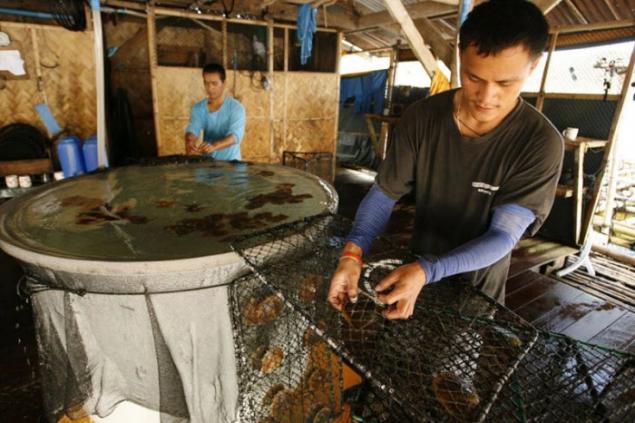
Young oysters are transported by helicopter to one of the neighboring farms for further growth.

Work makes daily cleaning process ropes and cells on one of the pearl farms.

Protection of farm stops vessel for inspection. In these places, a lot of poachers, so protection is always on the alert.
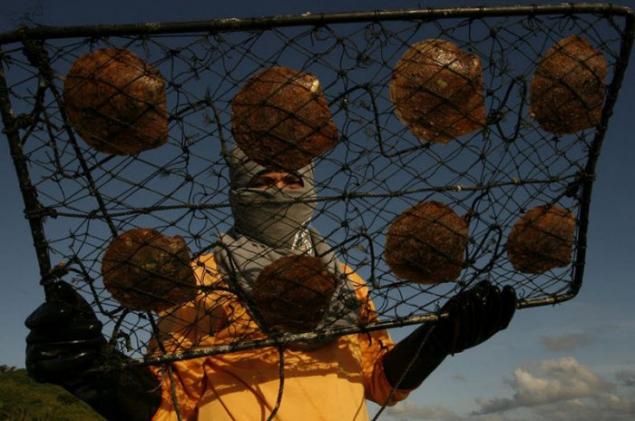
In 3 years the oysters are placed at a depth of 15 meters. Divers cells turn over every week to acquire a pearl of perfect round shape.



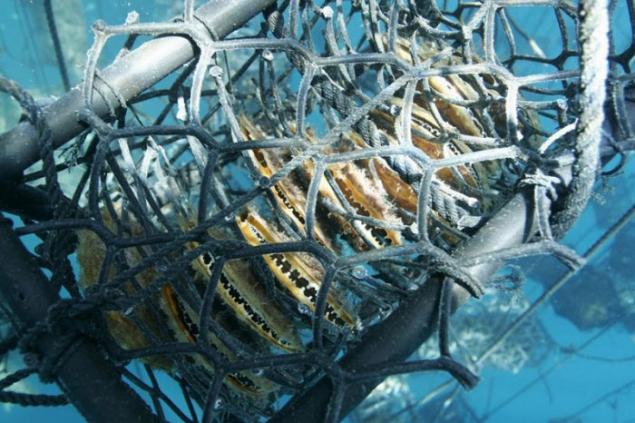
Workers lift cage with matured pearls.



How to harvest pearls.

Oysters are washed thoroughly before opening.

Jacques Brannel oversees the process of harvesting pearls on one of their farms, for which he came on his own helicopter from Manila.
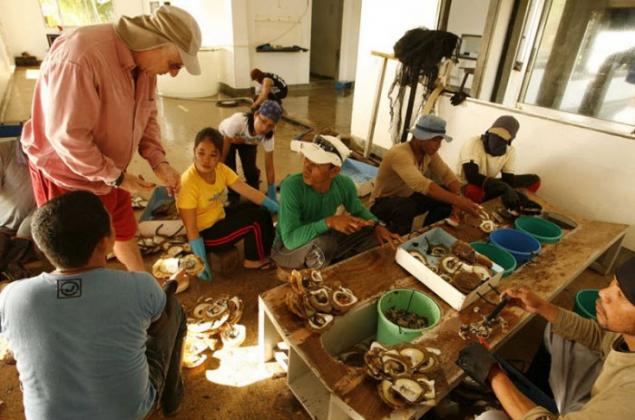

After 5 years of growth of the pearl oysters carefully removed. Only a few Japanese experts have the ability to open these oysters.


And the oysters in turn cleaned and sold to restaurants in Manila.

In one week of harvest mined thousands of pearls. Each sells for 500 euros. But top-class pearls can cost several times more.
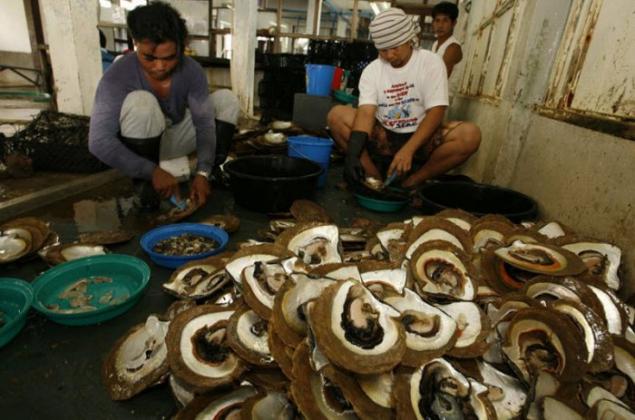
In workshops pearls are graded and assessed.
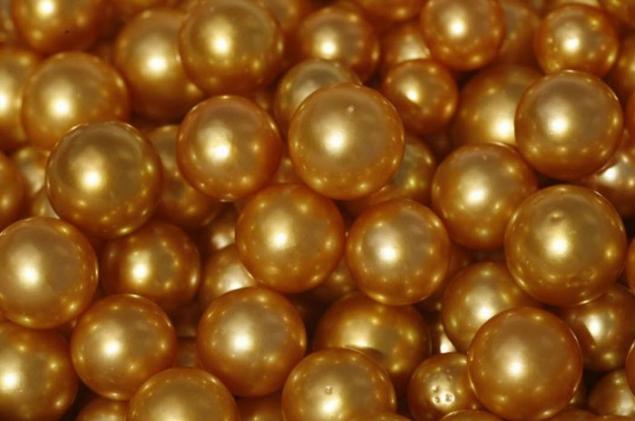
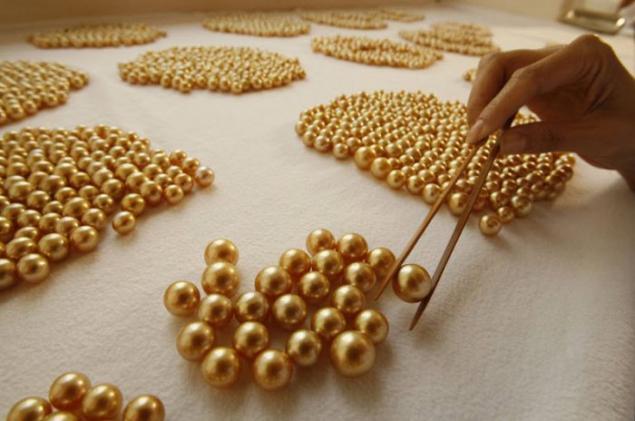
The designer developing new gold jewelry pearls.
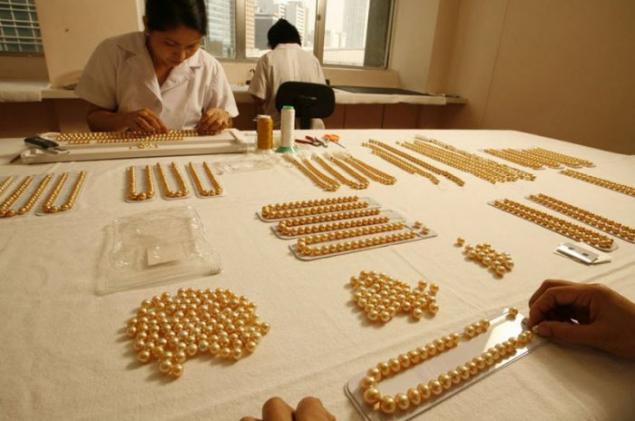
Gold jewelry pearls.



Jacques Brannel on his farm with an assistant, which is emblazoned on the neck a necklace of golden pearls.


A small motorboat maneuver between rows of ropes stretched over a vast area used for the production of gold pearls. Five divers wear a mask and diving and dive into the turquoise water. Coming season collecting pearls. In this place, surrounded on all sides by the 20 th islands, oyster-producing pearls, protected from strong currents. First oysters spend 2 years in an incubator, and then grow for 3 years at a depth of 15 meters in quiet warm waters of the South China Sea.
This farm of pearls are harvested is 500 km. from Manila and it is very well protected from the emissions of the big city. Absolutely all the forces thrown out to protect the oysters from external influence and negative impact on their growth.
Jacques Branell, since 1979 director and co-founder of the farm, is very worried about their possessions. He began to examine them more closely to the sky, flying his helicopter. No detail is overlooked. On the ground, he wears a pink shirt, hat and jogging runs to inspect the farm. In English, he gives orders to his Filipino assistant, who is trying everywhere to follow the chief.
In fact, Jacques is more concerned with what lies beneath the waves. Fishing with dynamite and cyanide are still prevalent among fishermen Palawan archipelago. Because of this, many corals have died, and now the same thing could threaten oysters. Owners pearl farms even provide local authorities with new motor boats so that they can closely monitor the fishermen and to protect the natural resources that are around.
View from the window of a helicopter of the islands of Palawan, which is a pearl farm.

"Cultivation of pearls is very labor-intensive process," explains Jacques. "Any change in temperature and water conditions may affect the oysters. Everything feels and experiences oyster, affects gem and can spoil its quality. "For 38 years I have been the cultivation of pearls, but still learning, constantly learning something new. Mining gold pearls very difficult task. To achieve perfection in this business you need to overcome a long way ».
Before you put oysters in the sea after 2 years incubator, each placed a small nucleus around which will grow a pearl. Then within 3 years divers ex will periodically get cells with oysters and turn them to pearls were perfectly round, as well as X-rays shine through them to make sure that everything is fine pearl.
But the most difficult part of the process of growing pearls oysters became excretion «Pinctada Maxima». 15 years, biologists have wrestled with breeding rare species of oysters. Now Jacques is the only company in the world that has the secrets of the production of gold pearls.
The divers returned to shore with the first part of the crop. They bring baskets full of oysters in which the pearls and are, but in spite of all the care for a few years, no one can guarantee excellent quality. A few hours later, in the studio, Jacques Brannel evaluates the first gems of the new harvest. "Not all the pearls may have a golden color, some are white or champagne color. From 700 thousand pearls that are produced on farms, Jacques, over 75% are considered to be of the highest quality pearls.
One of the workers bring the pearl, looking at which Jacques eyes light up. "This - the pearl of the highest quality - Hanadama», he exclaims with pride.
Among Jacques Brannelya employs more than 1,000 people in the Philippines are open 12 stores, which produced and sold the entire farm pearls.
Brannel Jacques, a former pilot of civil aviation, came to the Philippines for more than 30 years ago after being sold for the debts of his farm on cultivation of black pearls in Polynesia. But now he said that he had received good value for their previous failures. Jacques argues that does not pursue wealth, as already achieved everything he wanted. His house is located in the prestigious area of Manila, and most recently, he bought a small "Flower Island", where he rebuilt the former resort and made it their second home. Jack loves the Philippines, he married a local woman and dreams to his golden pearls have become a symbol of the archipelago, the same as it was black pearls in Tahiti.
Pearl Farm.

Jacques Brannel flew his helicopter to a pearl farm.



On this board the positions of all the cells are painted with oysters on the farm №3.

Biologist Doris Domingo, head of Fermilab, considering gold pearl under a microscope.

Oysters 3 ex-types: (left to right) a white, gold, black.

Young oysters are carefully cleaned of dirt and parasites, before placing them in the new cells.

Young oysters are transported by helicopter to one of the neighboring farms for further growth.

Work makes daily cleaning process ropes and cells on one of the pearl farms.

Protection of farm stops vessel for inspection. In these places, a lot of poachers, so protection is always on the alert.

In 3 years the oysters are placed at a depth of 15 meters. Divers cells turn over every week to acquire a pearl of perfect round shape.




Workers lift cage with matured pearls.



How to harvest pearls.

Oysters are washed thoroughly before opening.

Jacques Brannel oversees the process of harvesting pearls on one of their farms, for which he came on his own helicopter from Manila.


After 5 years of growth of the pearl oysters carefully removed. Only a few Japanese experts have the ability to open these oysters.


And the oysters in turn cleaned and sold to restaurants in Manila.

In one week of harvest mined thousands of pearls. Each sells for 500 euros. But top-class pearls can cost several times more.

In workshops pearls are graded and assessed.


The designer developing new gold jewelry pearls.

Gold jewelry pearls.



Jacques Brannel on his farm with an assistant, which is emblazoned on the neck a necklace of golden pearls.



